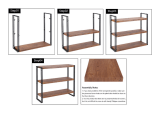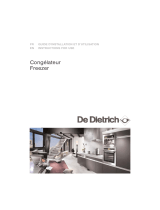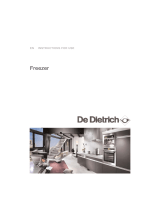
After installing your appliance, check that nothing has been damaged. Should you detect any
possible damage to the appliance, please contact your appliance salesman immediately.
Do not disperse packaging material such as plastic bags, polystyrene strips, etc., around the
environment. Keep such material away from children.
If the appliance has been transported in a horizontal position, do not plug in the
appliance but wait for a few hours in order to allow the oil to flow back into the
compressor. Place the appliance in a dry and aerated environment, duly protected from
weather elements. Avoid placing your appliance on balconies, verandas, terraces. Excessive
heat during summer and cold during winter could alter the good functioning operation of the
appliance or even damage it altogether.
Do not position your appliance near a source of heat like an oven or a central heating plant.
Do not place your appliance next to other pieces of furniture, but leave at least a 3 to 5 cm
space on the sides and 10 cm on the top.
Keep your appliance away from the wall by inserting spacers at the back of the said
appliance.
Adjust the front legs so that the appliance will lean slightly backwards, to allow the
door to close properly.
Clean your refrigerator compartment with a solution of sodium bicarbonate dissolved in water
(1 spoon for every 4 litres of water). Do not use alcohol, abrasive powders or detergents, as
these could ruin the surface.
This appliance works best when the ambient temperature is between 16 °C and 32 °C.
Hinges Adjustment
In case of any accidental bumps during
transport, the upper door may not be
perfectly aligned with the frame panel.
Should this occur, lightly loosen the
screw which fastens the pivot-holding
plate (A) to the upper hinge. Close the
door and align it with the frame panel.
Tighten the screw and check that the
gasket closes properly.
A
The first way to save electricity is to select the correct place for appliance installation as
specified above under installation instructions.
The second way to save electricity is to prevent heat from entering the refrigerator
compartments. Keep the refrigerator doors open for as little time as possible and never store
hot food inside, like soups or similar dishes in particular, as these will produce a great deal of
steam. Periodically check the door gaskets. Ensure the perfect closure of the doors. Should
this not be the case, please contact the Service Centre.
The third way to save electricity is to maintain the heat exchange parts in good condition.
Prevent condensation from accumulating in the refrigerator. Defrost the appliance whenever
the frost thickness exceeds 1-2 cm. This is not necessary with NO-FROST appliances. Clean
the condenser periodically as specified below in this Booklet.
Please ensure that the voltage (Volt, V) of the mains socket matches the indications on the
data plate which you will find inside your appliance.
Should the socket and the appliance plug not be compatible, do not use adapters,
multiple plugs or extensions, but have the socket replaced with another suitable kind
by qualified personnel.
The socket which feeds the appliance must be kept operational for future operations
(cleaning, defrosting, etc.).
Should the cable become damaged, replace it timeously by contacting specialized Service
Centres for the purchase and assembly of the said cable.
Electric safety of this appliance is assured only when it has been connected to a perfectly
effective earthing installation as specified in the electric safety norms in force.
14
Important: if the appliance has been transported to your house in a horizontal
position, please wait for a few hours before plugging in the appliance to allow oil to
flew back into the compressor.
Proceed with the Internal cleaning , then connect the appliance to the electric socket without
using an adaptor (see Electrical connection).
STARTING PROCEDURE
APPLIANCE INSTALLATION
ELECTRICAL CONNECTION
SAVING ENERGY
Installation of appliance equipped with wheels
If your appliance is equipped with wheels, remember that these do facilitate small handling
movements. However, do not pull the appliance for long stretches!
Adjust the legs so that the appliance leans slightly backwards.













